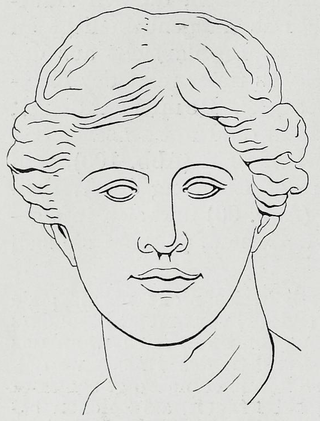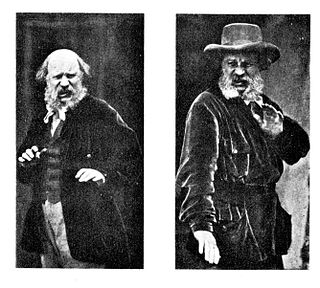Related Research Articles

The face is the front of an animal's head that features the eyes, nose and mouth, and through which animals express many of their emotions. The face is crucial for human identity, and damage such as scarring or developmental deformities may affect the psyche adversely.
A facial expression is one or more motions or positions of the muscles beneath the skin of the face. According to one set of controversial theories, these movements convey the emotional state of an individual to observers. Facial expressions are a form of nonverbal communication. They are a primary means of conveying social information between humans, but they also occur in most other mammals and some other animal species.

Facial perception is an individual's understanding and interpretation of the face. Here, perception implies the presence of consciousness and hence excludes automated facial recognition systems. Although facial recognition is found in other species, this article focuses on facial perception in humans.
Interpersonal attraction, as a part of social psychology, is the study of the attraction between people which leads to the development of platonic or romantic relationships. It is distinct from perceptions such as physical attractiveness, and involves views of what is and what is not considered beautiful or attractive.

Physical attractiveness is the degree to which a person's physical features are considered aesthetically pleasing or beautiful. The term often implies sexual attractiveness or desirability, but can also be distinct from either. There are many factors which influence one person's attraction to another, with physical aspects being one of them. Physical attraction itself includes universal perceptions common to all human cultures such as facial symmetry, sociocultural dependent attributes, and personal preferences unique to a particular individual.
Cuteness is a type of attractiveness commonly associated with youth and appearance, as well as a scientific concept and analytical model in ethology, first introduced by Austrian ethologist Konrad Lorenz. Lorenz proposed the concept of baby schema (Kindchenschema), a set of facial and body features that make a creature appear "cute" and activate ("release") in others the motivation to care for it. Cuteness may be ascribed to people as well as things that are regarded as attractive or charming.

Facial symmetry is one specific measure of bodily symmetry. Along with traits such as averageness and youthfulness, it influences judgments of aesthetic traits of physical attractiveness and beauty. For instance, in mate selection, people have been shown to have a preference for symmetry.

Benedict Jones is a research psychologist and lecturer at the University of Glasgow who studies the biological and social factors underlying face perception and preferences. He received his PhD from the University of St Andrews in 2005, where he studied with David Perrett.
The greebles are artificial objects designed to be used as stimuli in psychological studies of object and face recognition. They were named by the American psychologist Robert Abelson. The greebles were created for Isabel Gauthier's dissertation work at Yale, so as to share constraints with faces: they have a small number of parts in a common configuration. Greebles have appeared in psychology textbooks, and in more than 25 scientific articles on perception. They are often used in mental rotation task experiments.

Jonathon Stevens "Jon Driver" was a psychologist and neuroscientist. He was a leading figure in the study of perception, selective attention and multisensory integration in the normal and damaged human brain.

Sexual selection in humans concerns the concept of sexual selection, introduced by Charles Darwin as an element of his theory of natural selection, as it affects humans. Sexual selection is a biological way one sex chooses a mate for the best reproductive success. Most compete with others of the same sex for the best mate to contribute their genome for future generations. This has shaped human evolution for many years, but reasons why humans choose their mates are not fully understood. Sexual selection is quite different in non-human animals than humans as they feel more of the evolutionary pressures to reproduce and can easily reject a mate. The role of sexual selection in human evolution has not been firmly established although neoteny has been cited as being caused by human sexual selection. It has been suggested that sexual selection played a part in the evolution of the anatomically modern human brain, i.e. the structures responsible for social intelligence underwent positive selection as a sexual ornamentation to be used in courtship rather than for survival itself, and that it has developed in ways outlined by Ronald Fisher in the Fisherian runaway model. Fisher also stated that the development of sexual selection was "more favourable" in humans.

Disgust is an emotional response of rejection or revulsion to something potentially contagious or something considered offensive, distasteful or unpleasant. In The Expression of the Emotions in Man and Animals, Charles Darwin wrote that disgust is a sensation that refers to something revolting. Disgust is experienced primarily in relation to the sense of taste, and secondarily to anything which causes a similar feeling by sense of smell, touch, or vision. Musically sensitive people may even be disgusted by the cacophony of inharmonious sounds. Research has continually proven a relationship between disgust and anxiety disorders such as arachnophobia, blood-injection-injury type phobias, and contamination fear related obsessive–compulsive disorder.
Personality judgment is the process by which people perceive each other's personalities through acquisition of certain information about others, or meeting others in person. The purpose of studying personality judgment is to understand past behavior exhibited by individuals and predict future behavior. Theories concerning personality judgment focus on the accuracy of personality judgments and the effects of personality judgments on various aspects of social interactions. Determining how people judge personality is important because personality judgments often influence individuals' behaviors.

Melvyn Alan Goodale FRSC, FRS is a Canadian neuroscientist. He was the founding Director of the Brain and Mind Institute at the University of Western Ontario where he holds the Canada Research Chair in Visual Neuroscience. He holds appointments in the Departments of Psychology, Physiology & Pharmacology, and Ophthalmology at Western. Goodale's research focuses on the neural substrates of visual perception and visuomotor control.
Emotion perception refers to the capacities and abilities of recognizing and identifying emotions in others, in addition to biological and physiological processes involved. Emotions are typically viewed as having three components: subjective experience, physical changes, and cognitive appraisal; emotion perception is the ability to make accurate decisions about another's subjective experience by interpreting their physical changes through sensory systems responsible for converting these observed changes into mental representations. The ability to perceive emotion is believed to be both innate and subject to environmental influence and is also a critical component in social interactions. How emotion is experienced and interpreted depends on how it is perceived. Likewise, how emotion is perceived is dependent on past experiences and interpretations. Emotion can be accurately perceived in humans. Emotions can be perceived visually, audibly, through smell and also through bodily sensations and this process is believed to be different from the perception of non-emotional material.
Glyn W. Humphreys was a British cognitive neuropsychologist and academic. He was the Watts Professor of Experimental Psychology and principal investigator for the CNN Lab at Oxford University. He had previously worked at the University of Birmingham in the School of Psychology, where he held an honorary professorship of Cognitive Psychology. He died on 14 January 2016.

The cheerleader effect, also known as the group attractiveness effect or the friend effect, is a proposed cognitive bias which causes people to perceive individuals as 1.5–2.0% more attractive in a group than when seen alone. The first paper to report this effect was written by Drew Walker and Edward Vul, in 2013.
Jonathan B. Freeman is an American psychologist and associate professor of psychology at Columbia University. He is best known for his work on the neuroscience of person perception and social cognition, as well as mouse-tracking methodology in cognitive science. His research focuses on the cognitive and neural mechanisms underlying split-second social judgments and their impact on behaviour.
Ensemble coding, also known as ensemble perception or summary representation, is a theory in cognitive neuroscience about the internal representation of groups of objects in the human mind. Ensemble coding proposes that such information is recorded via summary statistics, particularly the average or variance. Experimental evidence tends to support the theory for low-level visual information, such as shapes and sizes, as well as some high-level features such as face gender. Nonetheless, it remains unclear the extent to which ensemble coding applies to high-level or non-visual stimuli, and the theory remains the subject of active research.
Malinda Carpenter,Ph.D, FRSE is a professor of developmental psychology at the University of St Andrews, an international researcher specialising in infant and child communications, prosocial behaviour and group reactions, in how people learn to understand others, and building self esteem; her work includes research between ape and human social cognition, and more recently in considering human-robotic communication futures.
References
- ↑ ‘PERRETT, Prof. David Ian’, Who's Who 2013, A & C Black, an imprint of Bloomsbury Publishing plc, 2013; online edn, Oxford University Press, Dec 2012 ; online edn, Nov 2012 accessed 11 May 2013
- ↑ Stephen, Ian D.; Coetzee, Vinet; Perrett, David I. (2011). "Carotenoid and melanin pigment coloration affect perceived human health". Evolution and Human Behavior. 32 (3): 216–227. doi:10.1016/j.evolhumbehav.2010.09.003.
- ↑ Perrett's profile on the University of St Andrews School of Psychology website Archived 2011-06-20 at the Wayback Machine
- ↑ David Ian Perrett Research Publications
- ↑ Moore, F. R.; Cornwell, R. E.; Law Smith, M. J.; Al Dujaili, E. A. S.; Sharp, M.; Perrett, D. I. (2010). "Evidence for the stress-linked immunocompetence handicap hypothesis in human male faces". Proceedings of the Royal Society B: Biological Sciences. 278 (1706): 774–780. doi:10.1098/rspb.2010.1678. PMC 3030856 . PMID 20843854.
- ↑ Stirrat, M.; Perrett, D.I. (2010). "Valid Facial Cues to Cooperation and Trust: Male Facial Width and Trustworthiness". Psychological Science. 21 (3): 349–354. doi:10.1177/0956797610362647. PMID 20424067. S2CID 23420343.
- ↑ Perrett, D. I.; Lee, K. J.; Penton-Voak, I.; Rowland, D.; Yoshikawa, S.; Burt, D. M.; Henzi, S. P.; Castles, D. L.; Akamatsu, S. (1998). "Effects of sexual dimorphism on facial attractiveness". Nature. 394 (6696): 884–887. Bibcode:1998Natur.394..884P. doi:10.1038/29772. PMID 9732869. S2CID 204999982.
- ↑ Putting beauty back in the eye of the beholder, The Psychologist, January 2002, Award Article for BPS President's Award.
- ↑ Vision Scientist Wins Golden Brain Award for Research Showing How the Brain Interprets Faces Archived 2011-07-18 at the Wayback Machine , The Minerva Foundation.
- ↑ "EPS Mid-Career Award 2008 Seeing the future: Natural image sequences produce "anticipatory" neuronal activity and bias perceptual report" (PDF). Retrieved 18 August 2011.
- ↑ British Academy Wolfson Research Professorships 2009 Archived 2011-09-30 at the Wayback Machine
- 1 2 Tiddeman, Bernard; Burt, Michael; Perrett, David (2001). "Prototyping and transforming facial features for perception research". IEEE Computer Graphics and Applications. 21 (5): 42–50. doi:10.1109/38.946630. hdl: 10023/1596 . Retrieved 26 February 2023.
- ↑ Perrett, David (2020). "Charlie Gross: An inspiration". Progress in Neurobiology. 195: 101928. doi:10.1016/j.pneurobio.2020.101928. hdl: 10023/24150 . PMID 33075448. S2CID 222814014 . Retrieved 26 February 2023.
- ↑ Spillmann, Lothar (2003). "Re-viewing 25 years of ECVP—A personal view". Perception. 32 (7): 777–791. doi:10.1068/p5112. PMID 12974564. S2CID 26492469 . Retrieved 26 February 2023.